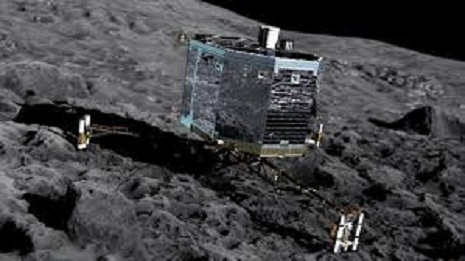Mission scientists had been trying to pinpoint its location since November -- until late Saturday.
What`s next for Philae?
At 10:28 p.m., the European Space Agency`s operations center in Darmstadt, Germany, just south of Frankfurt, received a signal from Philae, which transmitted more than 300 data packets. Those have been analyzed at the Lander Control Center at the German Aerospace Center, which dubbed Philae`s emergence from its seven-month slumber a "`hello` from space."
"Philae is doing very well. It has an operating temperature of -35ºC and has 24 watts available," Philae project manager Stephan Ulamec said in a statement. "The lander is ready for operations."
To hear mission managers on Twitter tell it, Philae`s comet-chasing mothership, Rosetta, was delighted to hear from the little lander but reluctant to let it delve back into work too hastily after its long sleep.
"Hello @ESA_Rosetta! I`m awake! How long have I been asleep? #Lifeonacomet," came the tweet from Philae`s handle.
"Hello @Philae2014! You`ve had a long sleep, about 7 months!" Rosetta responded.
"Wow @ESA_Rosetta! That`s a long time... time for me to get back to work! #Lifeonacomet"
"@Philae2014 Need to check you`re fit, healthy and warm enough first @philae2014! Take it easy for now :)"
"Oh, OK @ESA_Rosetta! I`m still a bit tired anyway... talk to you later! Back to #lifeonacomet!"
Months after Philae nodded off, lander system engineer Laurence O`Rourke told CNN that Philae needed almost 6 watts of power to reboot itself, 9 watts to accept communications and 19 watts to allow two-way communication with the orbiter -- not a great deal of power when you consider energy-saving lightbulbs use 20 watts or fewer.
There was speculation in March that Philae could be awake but lacking the necessary power to communicate with Rosetta, which was in orbit around Comet 67P looking for the washing machine-sized lander.
Scientists sent "blind commands" in hopes that the lander could process the instructions even if it couldn`t respond, O`Rourke told CNN in March. But there was not immense confidence that Philae could be revived.
Asked his thoughts Sunday, O`Rourke told CNN he was "thrilled" contact was re-established, which "allows us to do more science."
"We are all delighted -- delighted that Philae survived the long winter. It`s a great opportunity," he said.
When the lander snapped its hibernation spell Saturday, it "spoke" with the scientists on the ground for 85 seconds, ESA said.
"We have also received historical data -- so far, however, the lander had not been able to contact us earlier," Ulamec said, explaining that Philae must have been awake before Saturday
Scientists eagerly anticipate Philae`s next contact, as the lander`s memory still contains more than 8,000 data packets that will tell them what has happened in recent days on Comet 67P.
Since March 12, Rosetta has been listening for the lander to determine if it had survived the cold, dark recesses of the comet. Scientists promised that if enough sunlight could fall on Philae`s solar panels, it could be revived.
Problems began for the lander when devices designed to anchor Philae to the surface failed. The gravity is so weak that without the harpoons intended to fire from the feet, the probe bounced across the comet.
The mishap, said scientists, could prove to be a happy accident. Had Philae touched down in its original landing spot, O`Rourke explained, the temperatures as the comet neared the sun could have burned out the lander`s electronics, killing it altogether.
But because it found shade -- beneath a cliff face, scientists deduced from images sent by the lander -- it was able to survive.
Now, scientists are excited at the prospect of Philae witnessing a remarkable show as 67P makes its closest approach to the sun in August.
"I think we are going to see some amazing images at that point," O`Rourke has said.
ESA has led the consortium, which includes NASA, to find out more about the composition of comets and how they interact with the sun.
The mission is already changing perceptions of comets. Instead of thinking of a comet as a dirty snowball, O`Rourke has said, he now thinks of a comet as an "icy dirtball." He also described discoveries of dust and large "boulders" circling the comet after they were blown off by the sun during previous orbits, and an image that appears to show a structure the size of a football field that has been lifted and deposited next to the hole.
"The Rosetta mission is not just about the lander. It`s about orbiting and following a comet -- watching it wake up and then go to sleep again, finding the secrets held by comets. Every day is a new discovery," he said.
More about:
















































